XBAR AND R CHART
The Xbar and R chart is a very sensitive control chart for variables data. This pair of control charts is constructed so that a detailed analysis of the process location (mean) and spread (range) may be made.
Xbar and R charts offer several advantages. These include:
-
Detailed descriptions of an individual characteristic or variable
-
Maximum use of information included in variables data (using even a relatively small sample size )
-
Description of the performance of a manufacturing process even when all of the individual parts are within the product specifications
However, Xbar and R charts also have the following disadvantages:
-
They cannot be used with attribute data (go-no-go or pass-fail decisions).
-
Interpreters may confuse control limits and product specification limits without proper training.
STEPS FOR CONSTRUCTING AN XBAR AND R CHART
The following steps are involved in constructing an Xbar and R chart:
-
Determine the sampling frequency and sample size. Collect data from the process by sampling sets of three or more measurements. Take the sample subgroups at logical and regular intervals. The size of the sample is indicated by the letter n , and the number of sample groups by the letter k. For this charting method, the sample size ( n ) must remain constant for all sample groups. The parts that comprise the sample groups must also come from only one process stream (i.e., a single tool, head, die cavity , etc.). Although many control charts are constructed for characteristics for a product, process parameter may also be measured and used to control the manufacturing process. These measurements (speeds, feeds, cycles, times, temperatures , etc.) are often very useful for the prevention of quality problems.
-
Record measurements on the control chart. Because a chart for location (Xbar) and spread must be used for variables data, both of these chart forms and a data table are usually placed on the same sheet of paper. The vertical scales of the charts refer to the location of the Xbar and R values, and the horizontal scale indicates the sequence of sample groups across time, date, and/or production shifts. The data values, time index, and plotted points should be aligned vertically.
-
Calculate the mean and range for each sample. Calculate the mean (Xbar) and range for each sample group . These sample statistics serve as estimates of central tendency and spread for the manufacturing process.
Xbar
=
( X 1 + X 2 + ... + X n ) · n
R
=
X highest - X lowest
where X 1 , X 2 are individual values within the subgroup and n is the subgroup sample size.
-
Calculate the process center line. The average range (Rbar) and the process average (the mean of the sample means, Xdouble bar) serve as the process center lines. These values are typically calculated only after 25 or more sample groups have been collected from the process. Because the range chart represents piece-to-piece variation and information from this chart is used while calculating all control limits, the range chart is calculated and interpreted first.
Rbar
=
( R 1 + R 2 + ... + R n ) · k
Xdouble bar
=
(Xbar 1 + Xbar 2 + ... + Xbar n ) · k
where k is the number of subgroups, R 1 and Xbar 1 are the range and average of the first subgroup, R 2 and Xbar 2 are from the second subgroup, etc.
-
Calculate control limits for the charts. Control limits indicate the amount that sample ranges and averages would vary if only common causes of variation were operating. The control limits are based on the size of the sample groups and the amount of variation found within the subgroups. The within sample variation (piece-to-piece variation) is reflected by the sample ranges. The formulas for calculating control limits for both the Xbar and R charts are listed below.
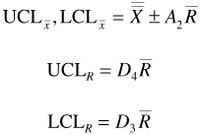
Constant values that vary by the sample size ( n ) are typically used for calculating control limits. The constants D 4 , D 3 , and A 2 are such constants, with values for sample sizes from 2 to 10, and are shown in Table 8.1.
| Chart for Ranges Divisors | ||||
|---|---|---|---|---|
| Subgroup Size | Chart for Averages (Xbar) Factors for Control Limits | Estimate of Standard Deviation | Factors for Control Limits | |
| n | A 2 | d 2 | D 3 | D 4 |
| 2 | 1.880 | 1.128 | ” | 3.267 |
| 3 | 1.023 | 1.693 | ” | 2.574 |
| 4 | 0.729 | 2.059 | ” | 2.282 |
| 5 | 0.577 | 2.326 | ” | 2.114 |
| 6 | 0.483 | 2.534 | ” | 2.004 |
| 7 | 0.419 | 2.704 | 0.076 | 1.924 |
| 8 | 0.373 | 2.847 | 0.136 | 1.864 |
| 9 | 0.337 | 2.970 | 0.184 | 1.816 |
| 10 | 0.308 | 3.078 | 0.0223 | 1.777 |
| 11 | 0.285 | 3.173 | 0.256 | 1.744 |
| 12 | 0.266 | 3.258 | 0.283 | 1.717 |
| 13 | 0.249 | 3.336 | 0.307 | 1.693 |
| 14 | 0.235 | 3.407 | 0.328 | 1.672 |
| 15 | 0.223 | 3.472 | 0.347 | 1.653 |
| 16 | 0.212 | 3.532 | 0.363 | 1.637 |
| 17 | 0.203 | 3.588 | 0.378 | 1.622 |
| 18 | 0.194 | 3.640 | 0.391 | 1.608 |
| 19 | 0.187 | 3.689 | 0.403 | 1.597 |
| 20 | 0.180 | 3.735 | 0.415 | 1.585 |
| 21 | 0.173 | 3.778 | 0.425 | 1.575 |
| 22 | 0.167 | 3.819 | 0.434 | 1.566 |
| 23 | 0.162 | 3.858 | 0.443 | 1.557 |
| 24 | 0.157 | 3.895 | 0.451 | 1.548 |
| 25 | 0.153 | 3.931 | 0.459 | 1.541 |
-
Determine the vertical scale for the Xbar and R charts. It is important to determine the vertical scale for a control chart after calculating the process center lines and the control limits. If the scales are determined before these calculations, the process center lines may be far from their expected positions at the center of the charts. In addition, careless selection of the chart scales may force the control limits beyond the range of the charts' scales. The vertical increments should be selected so that the plotting of the sample points is relatively simple and easily understood . Sometimes the divisions of the measuring device are used as the scale increments of the control chart.
The R value should be located about one third to one half of the distance from the bottom of the vertical scale of the R chart. The UCL R should be positioned approximately two thirds to three fourths of the distance up the scale. When the sample size is six or fewer, there is no lower control limit for the R chart.
The Xdouble bar value should be located at about the center of the scale on the Xbar chart. Center the control limits around about the Xdouble bar value and space them about one half to two thirds of the distance between the Xdouble bar value and the ends of the chart scale.
-
Plot the sample Xbar and R values. Plot the Xbar and R values for each sample on their respective charts. Place plotted points directly above the data and time sequence information included in the data table. The plotted points may be connected with a solid line as an aid to the analysis of patterns and trends in the data. Proofread the plotted points and compare them with the sample statistics, then draw the control limits and process averages on the charts and analyze the process for stability.
-
Draw the process center lines and limits on the charts. Draw the Xdouble bar and Rbar lines as solid horizontal lines. The control limits are usually drawn as dashed, bold horizontal lines. All lines should be labeled and dated. During the initial study phase, the lines are considered trial center lines and control limits. These may require recalculation as the process is modified and improved.
-
Analyze the range chart for process control. Because the control limits for both the range and averages charts are based on the value of Rbar, the R chart must be analyzed first. If the piece-to-piece variation is not stable, the control limits for the averages chart may be inappropriate and lead to false conclusions. Analyze the data points by comparing them with the control limits and examining them for unusual patterns or trends. Evaluate the process against the five criteria for process control before labeling it as stable and in control:
-
Are there one or more point(s) beyond the control limits?
-
Are there runs of seven or more points?
-
Are there trends of seven or more points?
-
Are there cycles of points?
-
Is there unusual variation (the 1/3 or 2/3 rule)?
-
If all of the plotted data in an R chart are within the control limits and randomly distributed around the center line, the spread of the process is stable and predictable (see Figure 8.1). This condition is a prerequisite for calculating ongoing control limits, studying capability, and generalizing experimental studies to longer and larger production runs.

Figure 8.1: A stable and predictable process.
If any of the plotted data are above the upper control limit (UCL, see Figure 8.2), this indicates one or more of the following:
-
The control limits have been miscalculated or have been drawn incorrectly.
-
The plotted sample that is above the control limit has been miscalculated or plotted improperly.
-
The within-sample (piece-to-piece) variation has increased from that of the past (and the nature of the excessive variation must be investigated).
-
The measurement system has changed.
-
Control limits calculated from these data are questionable (they are probably too small).
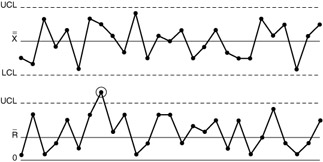
Figure 8.2: A process with a point out of UCL on the range chart.
When any of the plotted data are below the lower control limit (LCL, see Figure 8.3), it indicates one or more of the following:
-
The sample size ( n ) must be equal to or greater than seven (7) for there to be a lower control limit for this control chart.
-
The control limits have been miscalculated or have been drawn incorrectly.
-
The plotted sample that is below the control limit has been miscalculated or plotted improperly.
-
The process spread has decreased from that of the past (and the nature of the reduced variation should be investigated and made part of the manufacturing routine).
-
The measurement system has changed.
-
Control limits calculated from these data may be questionable (they are probably too large).
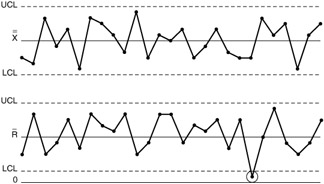
Figure 8.3: A process with a point out of LCL on the range chart.
If there is a run of seven (7) or more points above the Rbar (see Figure 8.4), this indicates one or more of the following:
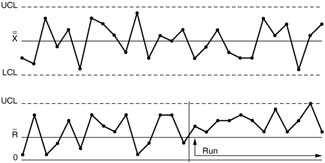
Figure 8.4: A process with a run above the Rbar.
-
A sustained decrease in the process capability.
-
The measurement system has changed.
-
All control limits may need to be revised because the process spread has changed.
A run of seven (7) or more points below the Rbar (see Figure 8.5) means one or more of the following:
-
The process spread has decreased (and the cause should be identified so that the improved process can be replicated).
-
The measurement system has changed.
-
The control limits may be questionable (they are probably too large or too wide).
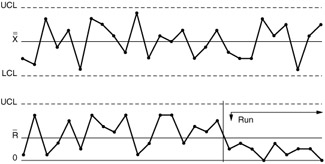
Figure 8.5: A process with a run below the Rbar.
An upward trend of seven (7) or more data points (see Figure 8.6) indicates that the process spread is increasing. This should be investigated immediately because process capability is degrading ”the variation is increasing.
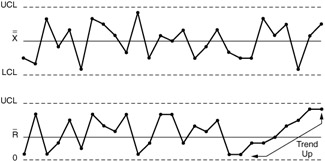
Figure 8.6: A process with a degrading trend.
A downward trend of seven (7) or more data points (see Figure 8.7) means that the process spread has decreased. The process is improving and the control limits may need to be recalculated. The process capability analysis should also be reassessed after the process is made stable and predictable at a new level of variation.
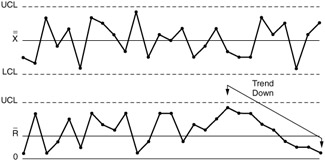
Figure 8.7: A process with an improvement in variation.
Cycles (see Figure 8.8) indicate repeating patterns of increasing and decreasing process spreads . These are opportunities for process improvement.

Figure 8.8: A process with cycles.
Unusual variation (see Figure 8.9) in the sample range means one or more of the following:
-
The control limits have been miscalculated.
-
The process or sampling plan is stratified.
-
The data have been edited and changed from the original readings .
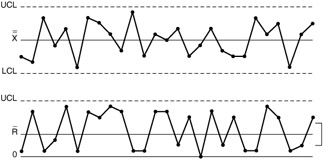
Figure 8.9: A process with unusual variation.
-
Analyze the Xbar chart for process control. Use the five criteria for process control to evaluate the Xbar chart. Identify and note all out-of-control conditions and factors that contribute to instability. The time, shift, date, material lot number, material vendor, process parameters, and production personnel included in the manufacturing operation during the out-of-control period should be noted in the process log. The problem-solving techniques discussed in Chapter 2 will help identify special causes of variation. Is there one or more points beyond the control limits?
-
Are there runs of seven (7) or more points?
-
Are there trends of seven (7) or more points?
-
Are there cycles of points?
-
Is there unusual variation (the 1/3 or 2/3 rule)?
If all of the plotted data on the Xbar chart are within the control limits and randomly distributed around the center line, the location of the process is stable and predictable (see Figure 8.10). The process is in control. This condition is needed for calculating ongoing control limits, studying process capability, and generalizing experimental studies to longer and larger production runs.
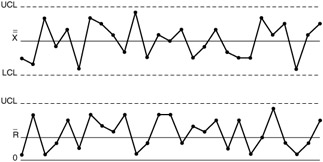
Figure 8.10: A stable and predictable process.If any of the plotted averages (Xbar) are outside of the control limits (see Figure 8.11), this indicates one or more of the following:
-
The control limits have been miscalculated or have been drawn incorrectly.
-
The plotted sample average that is beyond the control limit has been miscalculated or plotted improperly.
-
The process average has changed significantly from that of the past (and the cause for the process change must be identified and investigated).
-
The measurement system has changed.
-
The process center line calculated from these data is questionable because the center line is influenced by the extreme variation.
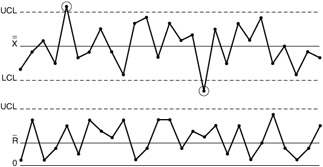
Figure 8.11: A process with points outside the UCL and LCL on the Xbar chart.If there is a run of seven or more averages on one side of the process average line (Xdouble bar, see Figure 8.12), this means one or more of the following:
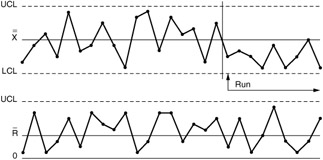
Figure 8.12: A process with a run below the Xdouble bar.-
The process location has changed (or is still different) from that of the past.
-
The measurement system has changed.
-
The control limits calculated from these data are questionable and may require recalculation.
A trend (up or down) of seven or more averages (see Figure 8.13) means that the process average is gradually changing or drifting. The cause of the change must be identified and assessed. Undesirable trends must be eliminated from the manufacturing process. Trends that are due to process improvement efforts must be stopped at an optimal setting. The process must be made stable and predictable at a new level. The process center line, control limits, and capability analyses must be recalculated after the process is controlled at a new level.
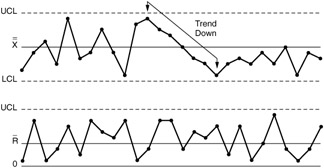
Figure 8.13: A process with a downward trend.Cycles indicating repeating patterns of high and low process locations (see Figure 8.14) indicate opportunities for improvement because a number of process settings have been observed . The factors that cause the different levels of the cycle and the optimal setting must be identified.
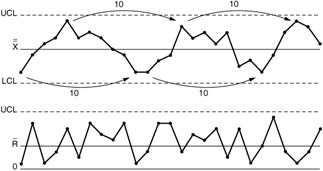
Figure 8.14: A process with cycles.Unusual variation (see Figure 8.15) in the sample averages means any or all of the following:
-
The control limits have been miscalculated.
-
The center line for the range chart has been miscalculated.
-
The process or sampling plan is stratified.
-
The data have been edited or changed from the original readings (excessive rounding errors).
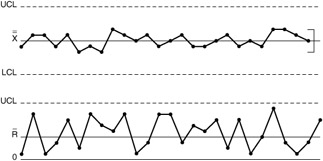
Figure 8.15: A process with unusual variation. -
-
Identify and eliminate the special causes of variation. How people react to control chart signals is the most critical aspect of the SPC program. If special variation is to be identified and eliminated, personnel must analyze the operation and all of the resources used during the actual process. In addition to the control chart, fishbone diagrams, Pareto charts, process flow charts, and controlled experiments may be needed to identify and resolve factors that create instability in the process. Promptness of reaction, elimination , and prevention of special causes of variation can never be overemphasized. A production department's reaction to out-of-control conditions indicates its commitment to understanding and controlling the manufacturing process. The control chart provides signals to help production departments maintain good quality.
-
Extend the control limits for ongoing process control. When the data from the process (at least 25 subgroups) are consistently within the control limits and in control, the control limits may be extended to future samples of data. The production operators and supervisors should closely monitor the charts and act promptly to correct special causes of variation. If the process is improved, or if extreme sources of variation are eliminated, the process center lines and control limits may no longer be appropriate. The changes made to the process may make it necessary to recalculate the process center lines and control limits.
-
Analyze the control chart data for process capability. After the process has been stabilized and is operating with only common sources of variation, assess the capability of the process. This analysis requires using a distribution to estimate the process population. The population is then compared and evaluated against the product specifications.
There are several alternatives to the Xbar and R (mean and range) chart. These other control charts for variables data are used for special situations that require characteristics that the standard Xbar and R chart cannot provide. One such chart is the X and Rm (individual and moving range).
EAN: 2147483647
Pages: 181